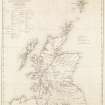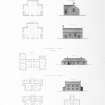Scheduled Maintenance
Please be advised that this website will undergo scheduled maintenance on the following dates: •
Tuesday 3rd December 11:00-15:00
During these times, some services may be temporarily unavailable. We apologise for any inconvenience this may cause.
Lochgilphead, Manse Brae, Old Manse
Manse (19th Century) (1830)
Site Name Lochgilphead, Manse Brae, Old Manse
Classification Manse (19th Century) (1830)
Alternative Name(s) Manse Brae; Lochgilphead Manse; Telford Manse, Parliamentary Church Manse
Canmore ID 120676
Site Number NR88NE 28
NGR NR 86611 88284
Datum OSGB36 - NGR
Permalink http://canmore.org.uk/site/120676
- Council Argyll And Bute
- Parish Kilmichael Glassary
- Former Region Strathclyde
- Former District Argyll And Bute
- Former County Argyll
Photographic Survey (April 1962)
Photographic survey of buildings in Lochgilphead, Argyll, by the Scottish Development Department (in the Scottish National Buildings Record Collection) in 1962
Field Visit (January 1987)
No. 172 Lochgilphead Town
In about 1750 Roy's Map showed a small settlement, perhaps sa single house, at 'Masnacurr' on the N shore of Loch Gilp. Its position at the junction of the roads from Inveraray to Oban and Campbeltown as improved in the 1770s made it a favoured venue for the meetings of public bodies, and Langlands's map of 1801 shows extensive linear development along the road, on the lines of the present Lochnell and Poltalloch Streets. This village was developed by John MacNeill of Gigha on the lands of Druim, part of his Oakfield estate, and a smaller village was laid out to the SE by Peter Campbell of Kilmory, in the area of Cossack Street, Paterson Street and Whitegates Road, at the entrance to his estate (No. 169).1* Campbell also built a quay at the SW end of Paterson Street (NR 863876), but the upper 1.6km of Loch Gilp is above low-water mark and the main marine development in the area was MacNeill's village of Ardrishaig at the SE end of the Crinan Canal (No. 261). The population of Lochgilphead was 1025 in 1825, and it reached a peak of 1674 in 1861, two years after becoming a police burgh (en.2).
From an early stage the town evolved in accordance with a numbered plan of sites, under strict conditions of feu or tack which controlled the height and appearance of buildings, and to this was attributed in 1845 the 'greatly improved' appearance of the town's houses (en.3). The Inveraray-Campbeltown road, following the line of the shore, forms an angle which opens on the N through Colchester Square into Argyll Street, the main N-S axis of the town, some 300m in length. The Inveraray road is bounded to the S by an area reclaimed from Loch Gilp for markets and other public purposes. Back streets, later known as Lorne Street and Union Street, were laid out parallel to Poltalloch and Lochnell Streets and running respectively WNW and SE from Argyll Street. These formed the bases of two grid developments, including alleys and other streets, which met in a wedge of garden ground behind the E frontage of Argyll Street.
The development of sites in Lochnell, Poltalloch and Argyll Streets, largely with two-storeyed houses, is recorded from 1811 onwards, while in 1815 a disposition of ground SW of the future Union Street specified the construction, on the street frontage, of 'a house of stone and lime and covered with slate ... to consist of one storey and a half’. The development of the W side of Colchester Square began in 1824, and of the E side, most of it by David Crow, a local builder and architect, in 1841 (en.4) The prominent site facing the head of Argyll Street was occupied in 1828 by a Parliamentary Church of standard design (en.5), which was replaced in 1885 by a church of Early English style with a gabled S front incorporating a steeple at the SW angle.
The town's industry was concentrated to the N, along the S bank of the Cuilarstich Burn, where various water-powered mills and a dye-house had been established by the 1820s. A two-storeyed building, probably of that period, survives in the present yard of D and J Carmichael, Ltd. Several public utilities were installed during the first half of the 19thcentury, largely at the expense of the proprietors: a piped water-supply from the mill-lade in 1807; a reservoir NE of the town, and side-drains in the streets, in 1831; and street lighting, supplied by a gasworks in Union Street, in 1844-6 (en.6).
The following descriptions are arranged by streets. Descriptions are given elsewhere in this volume of the Baptist Church, Argyll Street (No. 86), Christ Church Episcopal Church (No. 17) and a cross at St Margaret's Roman Catholic Church (No. 96).
ARGYLL STREET. This street is largely composed of plain 19th-century blocks of two storeys and attic, with rough-cast walls and painted offset margins. The least altered range, nos.71-85, stands on the W side and comprises five tenements, measuring 46.3m N-S by 8.5m (excluding later annexes). The two S tenements are dated 1859, and the central one 1828, while the five-bayed N tenement has a symmetrical E façade surmounted by a central gable with oculus, and a rear stairtower.Nos.2-8, on the E side of Argyll Street and immediately N of Colchester Square, comprise a pair of three-storeyed tenements with three-bay frontages, built in the first quarter of the 19th century. The S tenement, nos.2-4, measures 12.3m N-S by 8.8m and retains original external features-painted snecked rubble on the W facade, roughcast to Sand E, and painted offset margins to wand S. The N tenement, nos. 6-8, was altered about 1935 by the insertion of recessed canted bay-windows in the outer bays and enlarged plate-glass windows at the centre.
COLCHESTER SQUARE. Nos.5-11, Colchester Square a plain two-storeyed classical block built in 1822, occupies most of the W side of the square. It is built of rendered rubble with imitation-ashlar patterning to front, and a pitched slated roof with overhanging eaves. The E facade is nine-bayed, with three Doric-pilastered doorways, first-floor sash-and-case windows with offset margins, and roll skewputs, the former dated 1822, at SE and NE angles. Lochgilphead Post Office, an early-19th-century block occupying the E side of Colchester Square, is of two storeys and attic, and measures 31.2m N-S by 9.2m. Both the eleven-bayed W facade and the three-bayed S end-facade are of painted ashlar, with ground-floor Doric pilasters and modern windows, first-floor fenestration alternating between consoled architraves and moulded surrounds with lugged corners, and three mid-19th-century hip-roofed W dormers. There is a prominent cornice and eaves blocking course, and a single modern ridge chimneystack.
OLD MANSE, MANSE BRAE. This house is situated at the NE edge of the town (NR 866872), 'pleasantly situated on arising bank'? which falls to the SW. It was completed in 1828 as the manse for the Parliamentary church of the same date (supra). It was built to Telford's single-storeyed design, with advanced hip-roofed end-bays, but in the late 19th century the central part was heightened to two storeys, with gables and a stair-tower at the rear (E). The internal lay-out has been extensively altered, although some doors with fielded panels may be original.
PATERSON STREET. Nos.l-7, a two-storeyed terrace of four houses, stands on the SE side of Paterson Street opposite Kilmory Quay. It appears to correspond with the building shown on a block of feued ground in the Kilmory estate-plans of 1816, and fronted the new coastal line of the Inveraray road which had recently been diverted from the Kilmory policies. The terrace is built of roughcast rubble with offset freestone margins and dressings, and measures32.8m from NE to SW by 6.9m, excluding rear annexes. On the principal NW front each house is two-bayed with the exception of the SW one, no. 7, which is of three bays with an added timber porch.
POLTALLOCH STREET. This street, running W from Colchester Square, is built up on its N side with a mixture of two-storeyed early and mid-19th-century blocks, generally of plain roughcast appearance, and later-19th-century three-storeyed tenements. The earliest of the two-storeyed blocks (numbered I, Colchester Square) stands in the NW angle of Poltalloch Street and Colchester Square, and measures 12.2mby 8m. Its four-bayed S facade is rendered, with offset quoins and margins and roll-moulded SE skewputt. The E gable-wall is plainer in appearance, while an outside stair is situated to the N.
Islay Lodge. Of the villas at the Wend of Poltalloch Street, this two-storeyed building of early 19th-century date is the most noteworthy. Constructed of rendered rubble, its principal S facade is three-bayed with a central porch and is flanked by single-bayed E and W wings, one storey in height.
RCAHMS 1992, visited January 1987












